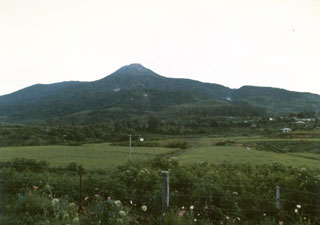Report on Talang (Indonesia) — June 2002
Bulletin of the Global Volcanism Network, vol. 27, no. 6 (June 2002)
Managing Editor: Richard Wunderman.
Talang (Indonesia) Small explosion earthquakes dominate through June 2002
Please cite this report as:
Global Volcanism Program, 2002. Report on Talang (Indonesia) (Wunderman, R., ed.). Bulletin of the Global Volcanism Network, 27:6. Smithsonian Institution. https://doi.org/10.5479/si.GVP.BGVN200206-261160
Talang
Indonesia
0.979°S, 100.681°E; summit elev. 2575 m
All times are local (unless otherwise noted)
During 11 March-16 June 2002 at Talang, seismicity was dominated by small explosion earthquakes (table 4). A thin white plume reached 50-100 m above the summit and sometimes drifted E. Hotspring temperatures were 42-64°C. As of 13 May, the Volcanological Survey of Indonesia (VSI) reported that no seismic data were available because of a broken seismograph. During April and early May seismicity had been decreasing. Talang remained at Alert Level 2 (on a scale of 1-4) throughout the report period.
Table 4. Earthquakes at Talang during 11 March-12 May 2002. The seismograph was broken as of 13 May, so no seismicity data was available through at least 16 June. Courtesy VSI.
| Date | Deep volcanic (A-type) | Shallow volcanic (B-type) | Small explosion | Tectonic |
| 11 Mar-17 Mar 2002 | 1 | 17 | 61 | 14 |
| 18 Mar-24 Mar 2002 | 2 | -- | 120 | 9 |
| 25 Mar-31 Mar 2002 | 2 | -- | 120 | 13 |
| 01 Apr-07 Apr 2002 | 2 | -- | 63 | 5 |
| 08 Apr-14 Apr 2002 | 1 | -- | 23 | 12 |
| 15 Apr-21 Apr 2002 | 3 | -- | -- | 6 |
| 22 Apr-28 Apr 2002 | 6 | -- | -- | 7 |
| 29 Apr-05 May 2002 | 4 | -- | -- | 14 |
| 06 May-12 May 2002 | 3 | -- | -- | 3 |
Geological Summary. Talang is part of a large volcanic edifice just NW of Dibawah Lake. An older volcanic peak, Pasar Arbaao, is ~1.5 km W. The steep-sided Talang cone exhibits fumarolic activity but has no crater; it appears to have grown within a larger caldera. Recorded eruptions have mostly involved small-to-moderate explosive activity, first documented in the 19th century, that originated from a series of small craters in a valley on the NE flank.
Information Contacts: Volcanological Survey of Indonesia (VSI), Jalan Diponegoro No. 57, Bandung 40122, Indonesia (URL: http://www.vsi.esdm.go.id/).

